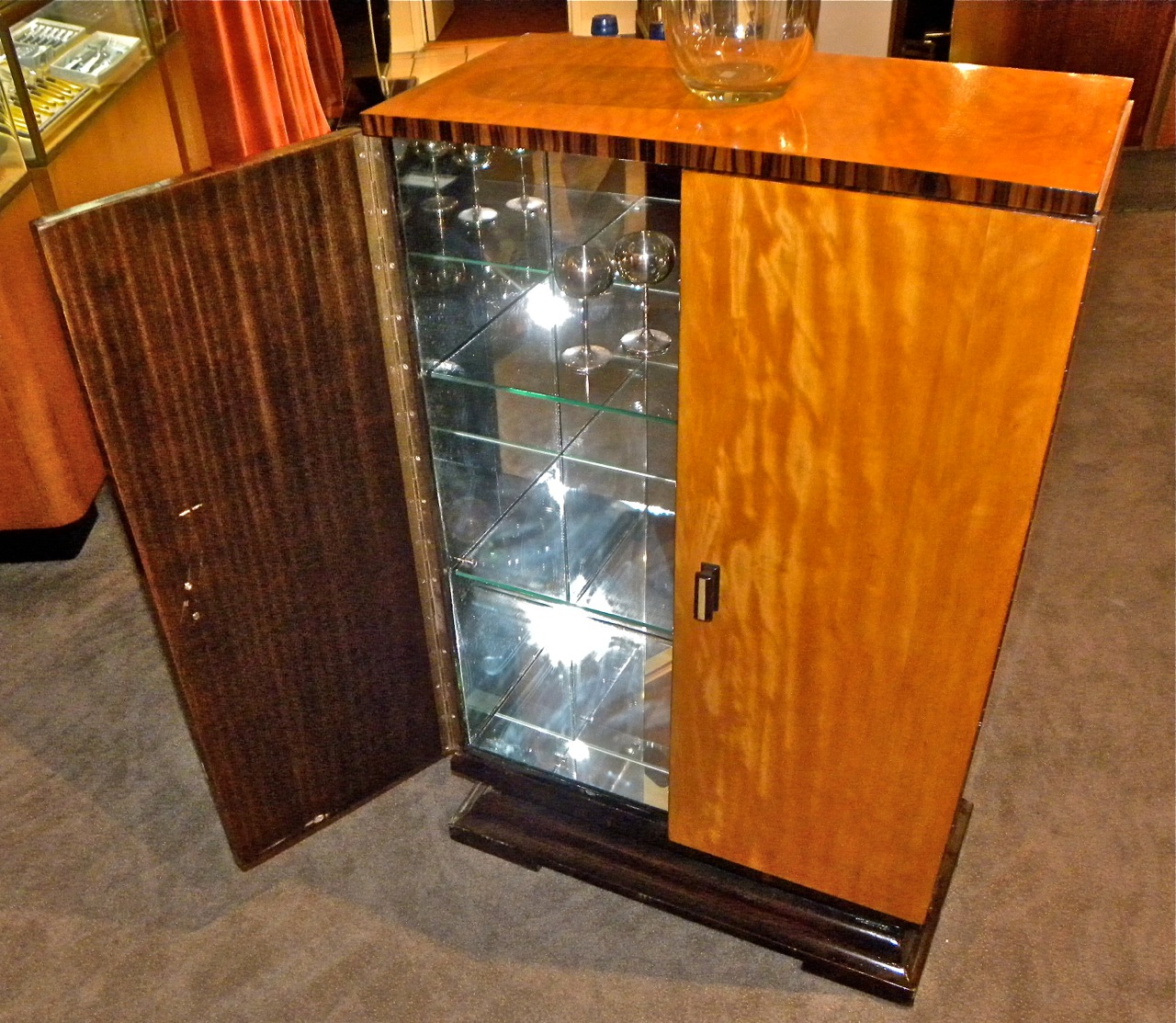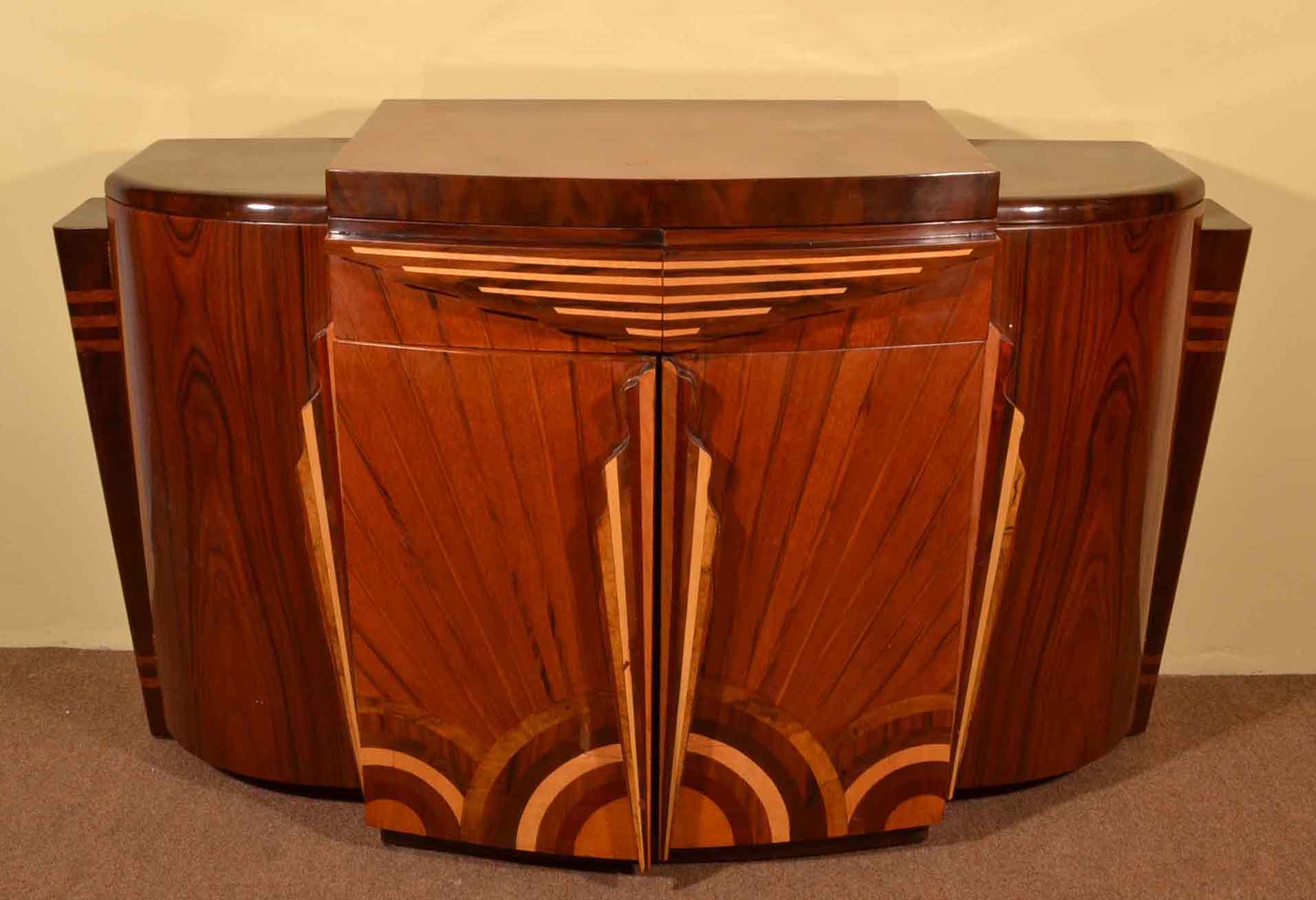Art Deco Design Elements

Art Deco, a design movement that emerged in the 1920s and flourished until the 1930s, was characterized by its bold geometric patterns, luxurious materials, and vibrant colors. This style was not just a decorative trend; it was a reflection of the era’s optimism, technological advancements, and fascination with the modern world. Art Deco furniture, including bar cabinets, embodies these characteristics in a striking and enduring manner.
Geometric Patterns
Geometric patterns are a defining feature of Art Deco design. These patterns are often symmetrical and feature bold lines, sharp angles, and repeating motifs. They create a sense of order, precision, and elegance.
- Sunburst Patterns: These patterns, resembling the rays of the sun, are frequently used in Art Deco furniture. They add a dynamic and energetic element to the design.
- Zigzag Patterns: Zigzag lines are another popular motif in Art Deco. They create a sense of movement and energy, often used in the design of bar cabinets to add visual interest.
- Chevron Patterns: Chevron patterns, consisting of a series of V-shaped motifs, are a distinctive feature of Art Deco. They add a sense of depth and texture to the design.
Bold Colors, Art deco bar cabinet
Art Deco embraced bold and vibrant colors, reflecting the optimism and exuberance of the era. These colors were often used in combination to create striking contrasts and visual excitement.
- Black and Gold: This classic Art Deco color combination represents elegance and luxury. It is often used in bar cabinets, with black lacquer finishes accented by gold trim.
- Red and Black: This bold color combination adds a sense of drama and sophistication to Art Deco furniture. It is often used in bar cabinets to create a striking and memorable design.
- Blue and Silver: This color combination evokes a sense of coolness and sophistication. It is often used in Art Deco bar cabinets to create a calming and elegant atmosphere.
Luxurious Materials
Art Deco furniture was often crafted from luxurious materials, reflecting the wealth and sophistication of the era. These materials added a touch of opulence and elegance to the design.
- Ebony Wood: This dark, rich wood was a popular choice for Art Deco furniture. It adds a sense of sophistication and luxury to the design.
- Macassar Ebony: This type of ebony wood features distinctive dark streaks and patterns, making it a highly prized material.
- Ivory: Ivory was often used in Art Deco furniture as a decorative element. It adds a touch of elegance and refinement to the design.
- Chrome: Chrome was a popular material for Art Deco furniture. It adds a modern and sleek touch to the design.
- Glass: Glass was also used extensively in Art Deco furniture. It adds a sense of lightness and transparency to the design.
Popular Materials and Finishes

Art Deco bar cabinets, like other pieces of Art Deco furniture, are renowned for their exquisite use of materials and finishes. The era’s embrace of luxury and craftsmanship is evident in the meticulous selection and execution of these elements, which contribute significantly to the overall aesthetic appeal and enduring value of these cabinets.
Wood
Wood, a timeless and versatile material, was a mainstay in Art Deco furniture. Its natural beauty and workability allowed for intricate designs and striking finishes. Here are some of the most common woods used in Art Deco bar cabinets:
- Mahogany: This rich, reddish-brown wood was a favorite for its elegance and durability. It was often used for the cabinet’s frame and doors, and its natural grain was frequently highlighted with polished finishes.
- Walnut: Known for its warm, dark brown tones and distinctive grain patterns, walnut provided a luxurious and sophisticated look. It was commonly used for veneers, creating intricate marquetry designs.
- Oak: While less common than mahogany or walnut, oak was also used in Art Deco bar cabinets. Its sturdy nature and distinctive grain patterns offered a more rustic and masculine aesthetic.
Metal
Metal played a significant role in Art Deco design, adding a touch of modernity and glamour to furniture. The use of metal in bar cabinets extended beyond structural elements to decorative accents and hardware.
- Chrome: Polished chrome, with its shiny, reflective surface, was a hallmark of Art Deco style. It was often used for hardware such as handles, hinges, and decorative accents, adding a touch of elegance and sophistication.
- Brass: Brass, with its warm, golden hue, was another popular metal used in Art Deco bar cabinets. It was often used for decorative accents, such as inlays, moldings, and decorative panels.
- Nickel: Nickel, with its silvery-white finish, offered a more understated and contemporary look. It was used for hardware and decorative elements, creating a subtle contrast with the wood or lacquer finishes.
Glass
Glass, another key material in Art Deco, was used extensively in bar cabinets to create a sense of openness and elegance.
- Clear glass: Clear glass was often used for doors and shelves, showcasing the contents of the cabinet while adding a touch of transparency and lightness.
- Frosted glass: Frosted glass, with its translucent, diffused surface, offered a more subtle and understated look. It was often used for doors or panels, adding a touch of privacy and sophistication.
- Colored glass: Colored glass, in shades of amber, emerald, or ruby, added a touch of vibrancy and sophistication to bar cabinets. It was often used for decorative accents, such as inlays or panels.
Lacquer
Lacquer, a resinous coating, was widely used in Art Deco furniture to create a high-gloss, durable finish.
- Black lacquer: Black lacquer was a popular choice for Art Deco bar cabinets, creating a sleek, sophisticated look. It was often used in combination with metal accents, such as chrome or brass, for a dramatic effect.
- Colored lacquer: Lacquer could also be applied in a variety of colors, such as red, green, or blue, adding a touch of vibrancy and individuality to the cabinet.
Finishes and Techniques
The finishes and techniques applied to the materials used in Art Deco bar cabinets played a crucial role in enhancing their aesthetic appeal and creating a sense of luxury and sophistication.
- Polished finishes: Polished finishes, such as those applied to chrome, brass, or wood, emphasized the natural beauty and luster of the materials.
- Marquetry: Marquetry, the art of inlaying different woods to create intricate designs, was a popular technique used in Art Deco furniture. It added a touch of elegance and craftsmanship to the cabinet’s surface.
- Inlays: Inlays, the use of different materials such as metal, glass, or ivory to create decorative patterns, were another common technique.
- Geometric patterns: Geometric patterns, inspired by the Art Deco movement’s fascination with geometric forms, were often incorporated into the design of bar cabinets, adding a touch of modernity and sophistication.
Aesthetic Appeal
The combination of materials and finishes in Art Deco bar cabinets created a unique aesthetic that was both modern and timeless. The use of luxurious materials like mahogany, walnut, and chrome, combined with intricate techniques like marquetry and inlays, resulted in furniture that was both functional and visually stunning. The high-gloss finishes and geometric patterns added a touch of glamour and sophistication, making these cabinets a true reflection of the Art Deco era’s embrace of luxury and craftsmanship.
Functionality and Features: Art Deco Bar Cabinet

Art Deco bar cabinets are not merely decorative pieces; they are functional works of art designed to enhance the entertaining experience. These cabinets are thoughtfully crafted to accommodate various barware and accessories, making them an essential addition to any home.
Common Features
The common features of Art Deco bar cabinets reflect their dual purpose of storage and display.
- Mirrored Doors: Mirrored doors are a hallmark of Art Deco design, adding a touch of glamour and reflecting light, creating an illusion of space. They also serve a practical purpose by allowing for a quick visual inventory of the cabinet’s contents.
- Built-in Liquor Shelves: These shelves are often tiered or staggered, providing ample space for storing bottles of various sizes. Some cabinets feature adjustable shelves for greater flexibility in organizing the collection.
- Ice Buckets: Many Art Deco bar cabinets incorporate built-in ice buckets, typically located within a drawer or compartment. This feature eliminates the need for separate ice storage and adds convenience during entertaining.
- Glass and Decanter Storage: Art Deco bar cabinets often include dedicated compartments for storing glassware, decanters, and cocktail shakers. These compartments are often lined with felt or velvet to protect delicate pieces and prevent clinking.
Configurations and Functionalities
Art Deco bar cabinets come in various configurations to suit different needs and spaces.
| Configuration | Functionality | Example |
|---|---|---|
| Freestanding | Can be placed anywhere in the room, offering flexibility in layout. | A freestanding cabinet with mirrored doors and a built-in ice bucket. |
| Built-in | Integrated into the wall, creating a seamless and space-saving design. | A built-in cabinet with a bar sink and a mirrored backsplash. |
| Corner | Maximizes space in corner areas, ideal for smaller rooms. | A corner cabinet with curved glass doors and a rotating liquor shelf. |
Practicality and Elegance
The features of Art Deco bar cabinets seamlessly blend practicality and elegance, making them perfect for entertaining and home decor.
“The mirrored doors create a sense of grandeur and reflect the light, making the room feel larger and more inviting.”
The built-in liquor shelves and ice buckets streamline the process of serving drinks, while the dedicated storage compartments keep glassware and accessories organized.
“The combination of functionality and style makes Art Deco bar cabinets a timeless investment for any home.”
An Art Deco bar cabinet, with its sleek lines and geometric patterns, can be a stunning focal point in any room. The cabinet’s design often evokes a sense of luxury and sophistication, reminiscent of the glamorous era it represents.
Similarly, a black recessed medicine cabinet can elevate a modern bathroom with its minimalist elegance. Just like the Art Deco bar cabinet, the black recessed medicine cabinet adds a touch of sophistication and functionality to the space.
An Art Deco bar cabinet, with its geometric lines and rich materials, can be a stunning focal point in any room. But if you’re looking for a more contemporary touch, consider a lighter approach, perhaps inspired by the serene elegance of light green painted kitchen cabinets.
A subtle green hue can create a sense of tranquility, just like the calming effect of a well-crafted Art Deco bar cabinet.